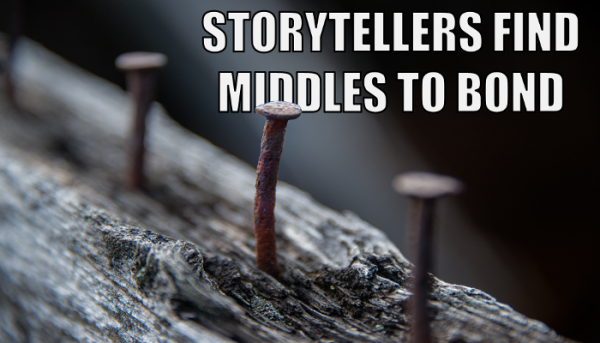
In last January’s post, How to Make Memorable Stories with Trigger Words, I described how people remember beginnings and endings over middles. But, just because we don’t remember middles, it doesn’t negate their importance. You see, we bond over the middles.
Middles separate us from the machines because they hold the common experiences of the human condition. While we may remember our first kiss and not our twenty-seventh, we know what it feels like to be kissed. The details of our individual memories may differ, but we’ve all felt embarrassment, have woken from bad dreams, and have been drawn into a bakery by the scent of freshly-baked bread. Master storytellers use middles to bond with their audiences.
Memories, Middles and the Chicken Men
My friend Dano Steinhardt is a talented street photographer who finds his subjects through unorthodox ways. For example, with a few spare hours before his flight out of Portland, he programmed his GPS for PDX, but rather than following the machine’s advice, he chose to do the opposite. If it told him to take a right, he took a left. If it told him to go north, he went south. Dano says that the more the voice protests, the closer he is to a “Dano shot.”
His anti-GPS method brought him to the Urban Iditarod (a.k.a. IDIOTarod), an event where costumed teams of liquored-up participants push shopping carts through the streets of Portland. He soon found himself in the company of the Chicken Men.

Humans commonly separate themselves into two groups: us versus them. When we’re part of the us group, it’s easy to gawk at the Chicken Men as the them group. But, what if we switched our point of view? What if it were us wearing the chicken heads and them were the gawkers? Not only would we bond as a group through the shared experience, but that bond would likely be stronger because of our small size compared to the larger them group.
Master storytellers connect with their audiences by simulating these bonding moments. They’re experts at finding ways to make us feel like them. For example, if I were telling a story about life as a Chicken Man, I’d need to find a common experience to build upon. With the odds that my audience had never donned a rubber chicken mask in public before, I’d need to uncover a middle–a common experience that could act as a surrogate. One simple way to uncover a common experience is to ask a “Have you ever…” question.
“Have you ever been in a situation where the world labelled you as odd, but you felt part of something special?”
The “Have you ever” technique uncovers middles to bond over. I use them frequently while presenting:
- “Have you ever been in a situation where time stood still?”
- “Have you ever looked around the room and wondered, “What the heck am I doing here?”
- “Have you ever wondered what it would be like to…?”
The “Have you ever” technique reveals a common experience that can bridge the gap between a new concept and an old one.
Give it a try. The next time you’re conveying a new concept to an audience, find a middle by seeking a “have you ever” moment.
Photo Credit: Both photos used in this post are courtesy of Dano Steinhardt. Check out his Between Meetings photo blog for more Dano goodness.